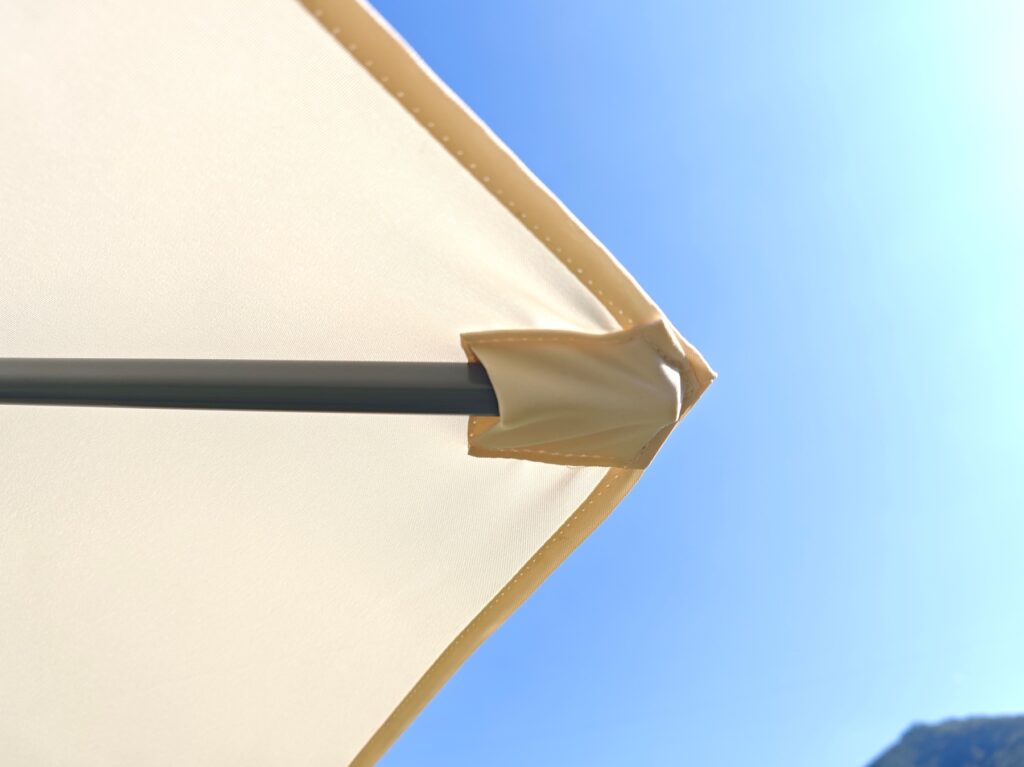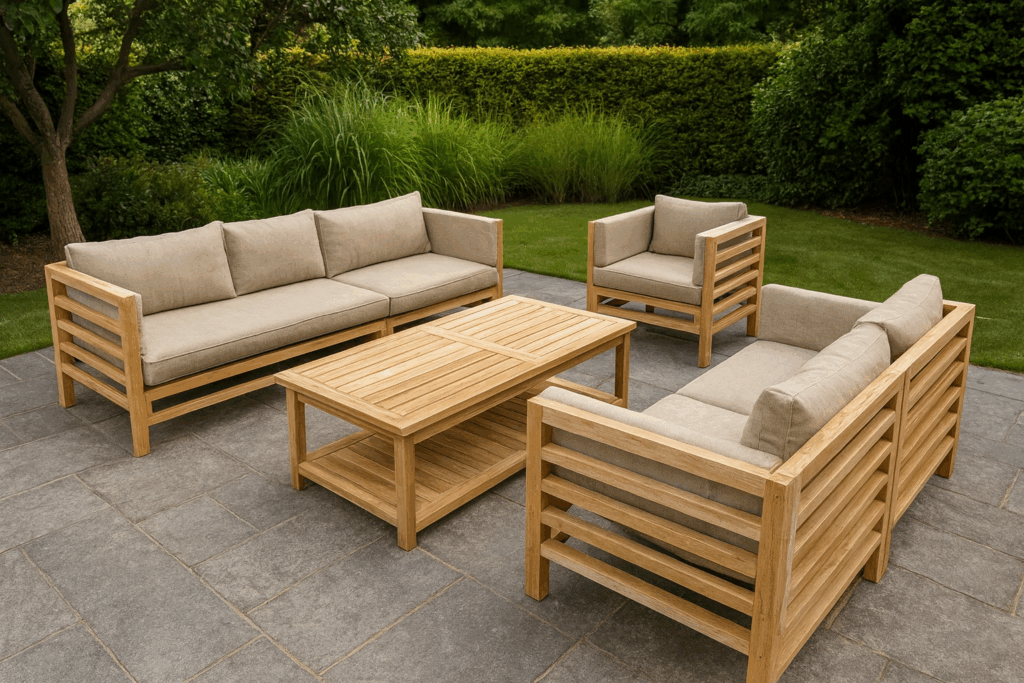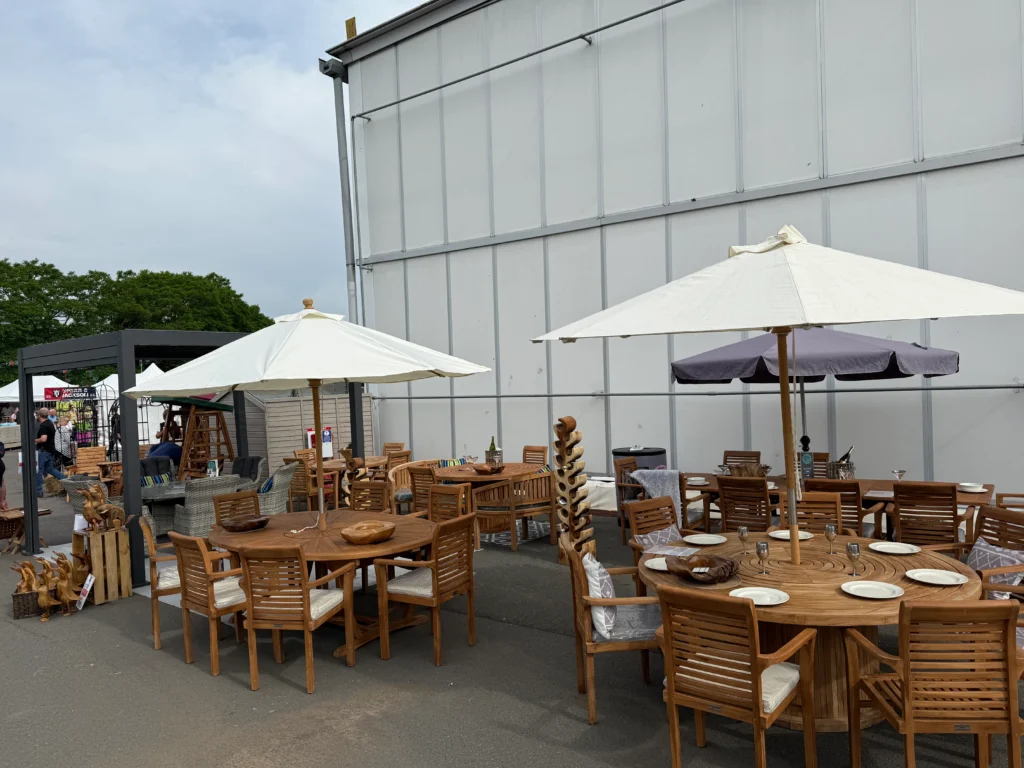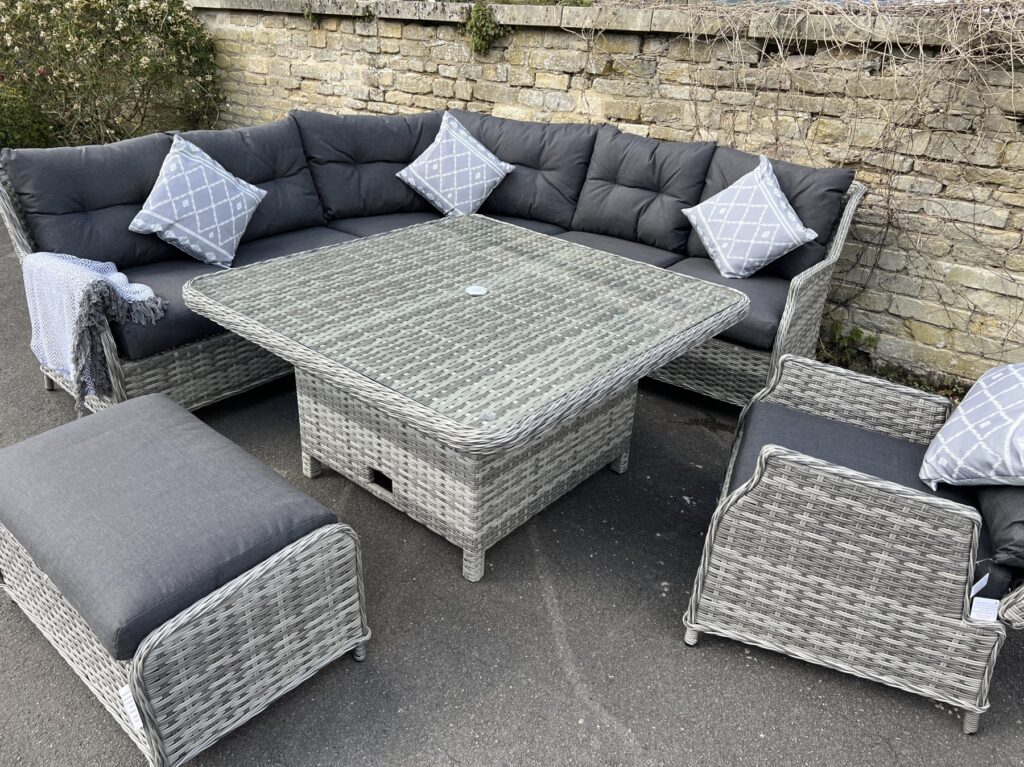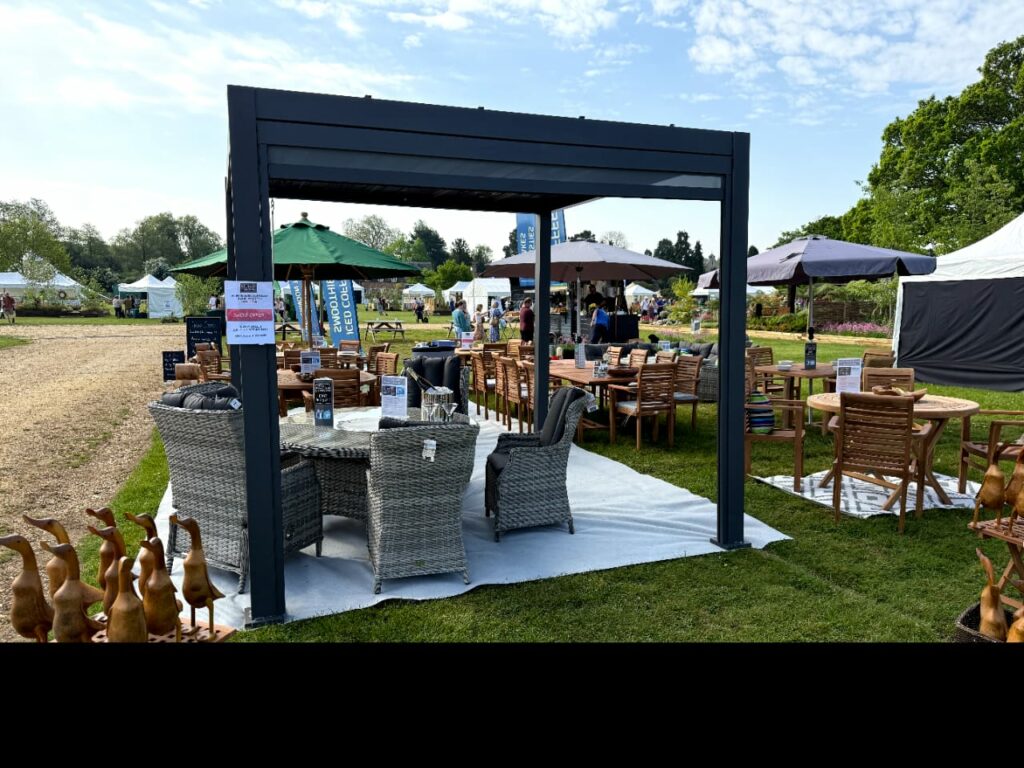Did you know that commercial awnings and verandas block up to 98% of harmful ultraviolet rays?
These silent salespeople don’t just enhance the visual appeal of your establishment and increase foot traffic, they also play a crucial role in protecting your outdoor furniture investment. For many business owners, outdoor spaces have become essential for attracting and retaining customers, but maintaining commercial outdoor furniture can be challenging with constant use and damage from the elements.
When we invest in restaurant awnings or commercial verandas, we’re not only creating comfortable outdoor dining experiences for our guests but also extending the lifespan of our teak garden furniture and other outdoor furnishings. With tables, benches, and other amenities, we show our customers that we care about their convenience and strive to enhance their experiences at our business.
The good news? With proper care and maintenance, these outdoor shade solutions can serve as an efficient, cost-effective and elegant means of extending your living space into the outdoors. Throughout this guide, we’ll explore how to properly maintain your outdoor furniture under these protective structures, ensuring both longevity and continued visual appeal for your commercial space.
Understanding the Role of Awnings and Verandas in Furniture Care
Commercial awnings and verandas serve as the first line of defence for your outdoor furniture investments. While many business owners focus primarily on their aesthetic appeal, these structures play a much more significant role in preserving your outdoor assets. Let’s explore how these protective installations safeguard your furniture and why they’re worth every penny.
How awnings and verandas protect outdoor furniture
The primary protection offered by commercial awnings comes from blocking harmful UV rays. Quality awnings can block between 90-98% of ultraviolet light, significantly reducing the damage to your outdoor furniture. This UV-blocking capability creates a substantial temperature difference—often 10-15 degrees cooler under an awning, which helps prevent heat-related damage to various furniture materials.
Beyond sun protection, commercial awnings and verandas create a protective barrier against rain and snow. This shield prevents moisture accumulation that leads to mould growth, swelling, and deterioration of furniture materials. For businesses with teak garden furniture, this protection is particularly valuable as it maintains the natural oils and integrity of the wood.
The microclimate created beneath awnings and verandas reduces overall stress on furniture materials. This controlled environment helps maintain structural integrity, preserving both appearance and functionality of your outdoor pieces over time.
Common issues caused by exposure without cover
Unprotected outdoor furniture faces numerous threats that can significantly shorten its lifespan. Understanding these risks highlights the importance of proper shade solutions:
-
Sun damage – UV rays cause fading, bleaching and weakening of materials, particularly affecting wood and fabrics. Continuous exposure leads to structural weakening, making furniture brittle and prone to cracking.
-
Water damage – Rain causes water stains on wooden furniture and encourages rot. For metal pieces, moisture accelerates rust formation, while fabric elements become breeding grounds for mould and mildew.
-
Temperature fluctuations – Constant heating and cooling cycles cause materials to expand and contract, leading to warping, cracking, and joint weakening.
-
Dirt and debris – Uncovered furniture collects pollen, leaves, and bird droppings, requiring frequent cleaning and potentially causing staining.
Why commercial shade solutions matter for longevity
Investing in quality commercial shade solutions makes financial sense for businesses. Protection from the elements significantly extends the lifespan of rattan garden furniture and other outdoor pieces, reducing the frequency of repairs and replacements.
For commercial spaces, this translates to considerable cost savings. Businesses with shaded areas spend less on replacing outdoor furniture, making commercial awnings and verandas a smart investment that eventually pays for itself through preserved assets.
Furthermore, commercial awnings enable businesses to transform unusable outdoor spaces into profitable areas. Restaurants can increase seating capacity with properly shaded outdoor dining areas, while retail establishments can display merchandise without worrying about sun damage or rain.
The best commercial shade solutions provide versatility through retractable systems, allowing businesses to adapt to changing weather conditions throughout the year. This flexibility maximises both protection and usability, ensuring your outdoor furniture remains in optimal condition regardless of seasonal changes.
Cleaning and Maintaining Furniture Under Cover
Even with the protection of commercial awnings and verandas, your outdoor furniture requires regular maintenance to preserve its condition and extend its lifespan. Proper care routines help prevent premature deterioration and maintain the professional appearance that customers expect.
Daily and weekly cleaning routines
Daily upkeep doesn’t need to be time-consuming. A quick wipe-down with a soft cloth removes leaves, dust, and unexpected rain puddles that can accumulate even under covered areas. For commercial spaces with high traffic, this simple habit prevents dirt buildup that can lead to more serious issues later.
Weekly maintenance should include checking and tightening any loose bolts or screws on your furniture. This five-minute job prevents wobbling chairs or tables that could embarrass you mid-service. Additionally, examine cushions for dampness and flip them regularly to prevent moisture from settling in.
How to clean under glass verandas and retractable awnings
Glass verandas require special attention to maintain their pristine appearance. Start by clearing the area of furniture and sweeping away debris to prevent scratches during cleaning. For the glass panels, use a mild, eco-friendly detergent mixed with warm water rather than harsh chemicals that might damage the surfaces.
For furniture situated under retractable awnings, remember to occasionally retract the cover to allow fresh air circulation. This practice helps prevent trapped moisture and reduces the risk of mould growth on your teak dining sets and other pieces.
Avoiding moisture build-up and mildew
Moisture is the primary enemy of outdoor furniture, causing issues like rust on metals, swelling in wood, and mildew growth on most surfaces. To combat this, regularly remove covers and allow furniture to air out. This simple step allows trapped moisture to escape, reducing the risk of mould development.
For persistent dampness issues, consider using a dehumidifier under your commercial veranda. Moreover, wiping down furniture surfaces helps remove excess moisture before it causes damage. During winter months, ensure proper ventilation by opening the area briefly to allow fresh, dry air to circulate.
Safe cleaning products for shaded areas
Choose gentle cleaning solutions that won’t damage your furniture. For most surfaces, warm water with mild dish soap provides effective cleaning without harming protective finishes. For tougher cleaning tasks, specific products like multi-surface cleaners formulated for garden furniture offer better protection through innovative nanotechnology.
When dealing with mildew stains, a solution of equal parts water and white vinegar works effectively. Alternatively, bicarbonate of soda paste serves as an excellent spot treatment. Always test cleaning products on a small, hidden area first to ensure they don’t cause discoloration.
By following these maintenance practices, we can maximise the protection that our commercial awnings and verandas provide, ensuring our rattan garden furniture and other outdoor pieces remain in excellent condition throughout the year.
Material-Specific Care Tips
Different outdoor furniture materials require specific care approaches, especially when placed under commercial awnings and verandas. Understanding these nuances can undoubtedly extend the lifespan of your valuable commercial outdoor pieces.
Teak furniture under awnings: link
Teak’s natural oils make it resistant to water and insects, yet it still needs attention under your commercial awnings. For regular cleaning, simply mix mild soap with lukewarm water and gently scrub with a soft-bristle brush. Unlike other woods, teak should never be varnished or painted as its natural oils prevent proper adhesion. Instead, apply a teak sealer once or twice yearly to maintain that golden honey-brown colour and protect against UV damage. For stubborn stains, lightly sand the surface rather than using harsh chemicals that might strip away the wood’s natural protective qualities.
Caring for rattan garden furniture: link
Rattan garden furniture requires gentle handling. Begin with a vacuum or brush to remove loose debris from the weave. For deeper cleaning, use a mild detergent solution and a soft brush to scrub away dirt without damaging the material. Synthetic rattan is more weather-resistant than natural varieties, though both benefit from protection under verandas. After cleaning, ensure the furniture dries completely to prevent mould formation in the intricate weave pattern – a common issue even under covered spaces.
Metal and aluminium furniture under verandas
Aluminium outdoor furniture offers excellent weather resistance and rust-free properties, making it perfect for commercial settings. Despite being low-maintenance, aluminium can develop a powdery white oxidation layer when exposed to the elements. To prevent this, clean surfaces regularly with warm water and mild detergent, avoiding alkaline-based cleaners that can further oxidize the metal. For added protection, apply a thin layer of car wax or silicon spray after cleaning. For steel or iron pieces under verandas, check frequently for rust spots and address them immediately with a mixture of water and white vinegar before they spread.
Fabric cushions and parasols: cleaning and drying tips
Fabric elements need special attention even under protective structures. For cushions, remove covers if possible and wash according to manufacturer instructions. If non-removable, spot clean with mild soap and water, blotting rather than rubbing to prevent fabric damage. Always ensure cushions dry completely before use – stand them upright to improve air circulation. For parasols and awning canopies, a gentle clean with mild detergent helps maintain water resistance. Remember that parasol fabric should never be removed for cleaning as it could shrink or lose shape. Instead, clean it while fully opened and stretched to maintain structural integrity.
By applying these material-specific techniques, your commercial outdoor furniture will remain in prime condition year-round, enhancing customer experiences and protecting your investment.
Seasonal Maintenance and Storage
Proper seasonal maintenance extends the life of your investment in outdoor dining spaces. Even with awnings and verandas providing protection, seasonal care remains essential for commercial furniture durability.
Preparing furniture for winter under verandas
Early autumn (September-October) is ideal for winter preparations while weather remains mild and dry. Begin by examining all furniture for wear, loose parts, or damage. Afterwards, apply appropriate protective coatings—wood preservatives for teak pieces, rust-resistant primer for metals, and UV protectants for plastics. Ensure furniture legs aren’t directly on grass, as this causes moisture absorption. Place stones or wooden blocks underneath to create separation from damp ground.
When to store vs when to cover
The decision between storing or covering depends on several factors. Choose indoor storage for high-value furniture, during extreme weather conditions, or when furniture won’t be used throughout winter. If storage space is limited, moving furniture to sheltered positions under fixed verandas or commercial awnings offers a practical alternative. Ultimately, a hybrid approach works best—using covers during mild weather and storing more vulnerable items like cushions and teak dining sets during harsh winter periods.
Using breathable covers under commercial awnings
Contrary to popular belief, waterproof covers aren’t ideal for furniture. Instead, opt for water-resistant, breathable covers that repel most water while allowing air circulation. These breathable covers prevent paint damage, rust, mildew, and water stains by allowing moisture to evaporate quickly. Look for covers with water-resistant seam binding and built-in mesh vents that promote airflow. Secure covers properly with drawstrings, toggles, or buckle clips, preventing them from blowing away during winter storms.
Checklist for spring re-opening
Once winter passes, thoroughly inspect your rattan garden furniture and other pieces with this quick checklist:
-
Check structural integrity—tighten loose screws and fasteners
-
Clean surfaces with a solution of three parts water to one part white vinegar for light mould removal
-
Examine furniture for rust spots, addressing them immediately
-
Test protective coatings and reapply if necessary
-
Give everything a quick weekly wipe-down to prevent buildup as the season progresses
By implementing these seasonal maintenance practices, your commercial outdoor furniture will remain in excellent condition year-round, hence maximizing both customer satisfaction and your investment’s lifespan.
Common Mistakes and How to Avoid Them
Even careful business owners make common mistakes when maintaining outdoor furniture under commercial awnings and verandas. Recognising these errors can save you time, money, and frustration.
Using pressure washers on awning-covered furniture
Contrary to popular belief, pressure washers are rarely suitable for outdoor furniture cleaning. High-pressure water can tear fabric, strip paint, and dent metal surfaces. Although your teak garden furniture sits under protective covering, pressure washing will likely cause more damage than benefit. Alternatively, opt for gentle cleaning with mild soap and water, using soft brushes for stubborn areas. For professional results, consider specialist furniture cleaning services familiar with commercial requirements.
Neglecting ventilation under fixed verandas
Fixed verandas create magnificent dining spaces yet can trap moisture without proper ventilation. This enclosed environment becomes ideal for mildew growth, particularly affecting rattan garden furniture with its intricate weaving patterns. To prevent this, ensure periodic airing by removing furniture covers occasionally and creating airflow through the space. For glass verandas, consider installing small vents or occasionally opening doors to reduce humidity levels.
Overlooking hardware and joints
Structural integrity often fails because we forget to check the less visible parts. Bolts loosen over time, hinges rust, and joints weaken—issues that simple weekly inspection can prevent. Create a quick maintenance checklist that includes examining all hardware and connection points. Immediately addressing any loose components prevents wobbling tables that could embarrass you mid-service or potentially lead to more expensive repairs.
Not drying fabric before storage
“Cushions should never be left out in the rain,” reminds industry experts, adding that even water-resistant varieties can develop mildew if improperly stored. Always ensure cushions and fabrics are “bone dry” before storing them away. For teak dining sets with cushions, establish a dedicated dry, ventilated storage space for fabric components. This simple step prevents the unpleasant surprise of mouldy cushions when reopening your outdoor space after winter.
Ultimately, avoiding these common pitfalls ensures your commercial outdoor furniture maintains both its appearance and functionality, providing comfortable spaces for your customers throughout the year.
Conclusion
Proper care of commercial outdoor furniture stands as a worthwhile investment for any business owner. Throughout this guide, we’ve seen how commercial awnings and verandas serve as silent guardians, blocking harmful UV rays while creating comfortable spaces for customers. These protective structures significantly extend the life of your outdoor furnishings, though they certainly don’t eliminate the need for regular maintenance.
Daily and weekly cleaning routines undoubtedly make a difference, particularly when paired with material-specific approaches. Your teak dining sets will thrive with gentle cleaning and occasional sealing, while rattan garden furniture requires careful attention to prevent moisture build-up in its intricate weaves.
Seasonal maintenance further protects your investment, especially during harsh winter months. The decision to cover or store furniture depends on your specific situation, though breathable covers often provide the best solution under fixed structures. Additionally, spring reopening becomes much easier when you’ve properly prepared your furniture for winter hibernation.
Many business owners fall into common maintenance traps such as using pressure washers, neglecting ventilation, or overlooking hardware and joints. Avoiding these mistakes saves money and extends the lifespan of your commercial furniture. After all, wobbling tables and mildewed cushions hardly create the professional atmosphere customers expect.
The care you show toward your outdoor furniture directly reflects your attention to detail throughout your business. Customers notice these small touches—the well-maintained teak tables, the spotless rattan chairs, the sturdy parasols. These elements combine to create inviting outdoor spaces that keep patrons returning time and again. Consequently, your diligent maintenance not only preserves valuable assets but also enhances the overall customer experience, making it well worth the effort.



